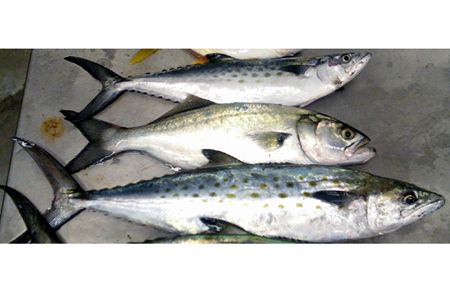Uncovering The Function Of Fish Shapes

(ISNS) -- One fish, two fish, skinny fish, flat fish – scientists and anglers alike have long wondered about the connection between how the shape of a fish determines how it moves. Researchers are starting to unravel the secrets of fish motion – using some unexpected methods.
Kara Feilich, a graduate student in comparative biomechanics at Harvard University, used plastic strips and the tails of real fish attached to robotic flappers to figure out what shape of tail will propel a fish the fastest. She presented some of her results at the annual Society for Integrative and Comparative Biology meeting earlier this month in San Francisco.
Feilich said that she first became interested in the topic when she looked at some research papers published in 1984 by Paul Webb, a zoologist at the University of Michigan. Webb's work hinted at "patterns of convergence in body shapes," explained Feilich.
Webb wrote that tuna and sharks had similar bodies – efficient at cruising through the water at high speeds. In contrast, pike are thick and good at accelerating. Flounder have flexible bodies, and their rounded forms are optimized for quick acceleration and maneuvering, but their large surface area works against sustained high-speed swimming. If a fish needs high maneuverability, rounded fins seem to work better than pointy fins. But, said Feilich, Webb did not gather any empirical data.
Feilich decided to investigate the theory that the form of a fish's body yield information on its functioning. She tested how the shape of the back third of the fish, which seems to be the most vital to movement, impacted its ability to swim quickly. She attached four different shapes and thicknesses of plastic strips to a robotic fish body to imitate flexibility in a fish tail – tuna have stiff tails while blue sunfish have flexible tails. Feilich also tried using some fresh fish tails of different shapes from a market in Cambridge, Mass., where she said she is on a first-name basis with the fishmongers.
What Feilich found was a picture that was more complex. A medium stiffness and form was the fastest, but much more work needs to be done to understand the dynamics behind it.
"Our field's understanding has changed with the understanding of fluid mechanics, but so far the study of hydrodynamics lags behind what we know about movement on air or land," Feilich said.
Sign up for the Live Science daily newsletter now
Get the world’s most fascinating discoveries delivered straight to your inbox.
Paul Webb agrees that the picture is complex. He said that a fundamental problem scientists have in looking at the role of shape is that fish have different niches, histories, and trade-offs, so it is very difficult to isolate the effect of structure from other things. For example, eels are essentially shaped like aquatic worms -- designed for hiding away and sticking in holes.
"But you see eels making long migrations, very slowly. Just because certain body forms are good at certain things, they don't exclude other functions. As an evolutionary strategy, it works," said Webb.
That brings him to what Webb calls "the 800-pound gorilla" when it comes to evolution, an animal doesn't have to be perfect – it just has to do a little better than its competition. Swimming fast may not be the thing that every fish is trying to maximize.
John Long, deputy director for research and collections at the Natural History Museum of Los Angeles, who studies fish evolution, said that the research is innovative in its approach to the problem of how the shape of fish tails impacts its swimming abilities.
"I feel that the results of such work will enable us to better understand in particular the initial the takeoff speeds and accelerative abilities of key fish species, and that information might one day help the next generation of fishermen improve their catch," said Long.
Vlad Kopman, a roboticist and graduate student at the Polytechnic Institute of New York University, in Brooklyn, said that robotic swimmers are beginning to mimic the real world of fish. His research, along with his adviser Maurizio Porfiri, is creating a life-size robotic fish that mimics a regal tang in body shape and size.
"This robot is not directly intended for robot-animal studies but rather for additional investigations of bio-mimetic locomotion, the control strategies necessary for maintaining such as locomotion, and as an educational instrument for future outreach activities at local public aquariums," said Kopman.
Feilich said that even though she's more interested in the evolutionary ecology of fish, uncovering the secrets of fish motion can help engineers build better biomimetic robots underwater– and also in the sky.
"What applies to one fluid can apply to another," Feilich said. "Having different sciences draw from each other to answer evolutionary questions is really important. We couldn't do this without engineers."
Katharine Gammon is a freelance science writer based in Santa Monica, Calif., and writes for a wide range of magazines covering technology, society, and animal science.
Inside Science News Service is supported by the American Institute of Physics.












